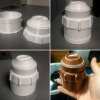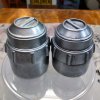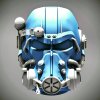Yodajammies
Sr Member
Like everyone else, I got bit by the Fallout bug pretty badly in November. I've settled in on building the T-60 armor as my big 2016 project and here looks like as good a place as any to start the build log.


The first piece I'm focusing on is the gauntlet / hand. I've wanted to build a direct linkage articulated hand for the longest time now and this build is absolutely perfect for it. My main software for designing this suit will be Rhino5 though Solidworks would be more appropriate for these hand assemblies. Being able to flex and move the mechanism in real-time would be a huge perk but as long as my math is good and the alignment of parts is accurate, Rhino should suffice.
For the wrist articulation I'm using a simple ball and socket mech where the gauntlet will clamshell over the hand and provide for full motion. The springloaded pull triggers will be housed inside the "hand ball" and will be designed to be modular so that repair/replacement won't be a total nightmare.


The finger angles and linkages.

One of the most important goals I'm keeping in mind while designing these parts is weight reduction. This first test prototype weighs in at nearly a quarter pound and if we extrapolate this out to the entire hand mech with all of its parts, hardware, cable pulls, etc, we'd be looking at atleast 3-5lbs per assembly. This suit is already going to be a monster and carrying around an extra 5 pounds in just the hands will not fly. I'm currently going back through and shaving down any excess material that I can in order to reduce weight and material cost without sacrificing strength and structural integrity.


The current working design still has some quirks to it that need to be ironed out but I'm liking the direction it is taking. It looks like I'll need another week or so of pushing surfaces around before I'm solidly ready to buy all the hardware on the BOM and start fabricating a working prototype.




The first piece I'm focusing on is the gauntlet / hand. I've wanted to build a direct linkage articulated hand for the longest time now and this build is absolutely perfect for it. My main software for designing this suit will be Rhino5 though Solidworks would be more appropriate for these hand assemblies. Being able to flex and move the mechanism in real-time would be a huge perk but as long as my math is good and the alignment of parts is accurate, Rhino should suffice.
For the wrist articulation I'm using a simple ball and socket mech where the gauntlet will clamshell over the hand and provide for full motion. The springloaded pull triggers will be housed inside the "hand ball" and will be designed to be modular so that repair/replacement won't be a total nightmare.


The finger angles and linkages.

One of the most important goals I'm keeping in mind while designing these parts is weight reduction. This first test prototype weighs in at nearly a quarter pound and if we extrapolate this out to the entire hand mech with all of its parts, hardware, cable pulls, etc, we'd be looking at atleast 3-5lbs per assembly. This suit is already going to be a monster and carrying around an extra 5 pounds in just the hands will not fly. I'm currently going back through and shaving down any excess material that I can in order to reduce weight and material cost without sacrificing strength and structural integrity.


The current working design still has some quirks to it that need to be ironed out but I'm liking the direction it is taking. It looks like I'll need another week or so of pushing surfaces around before I'm solidly ready to buy all the hardware on the BOM and start fabricating a working prototype.


























